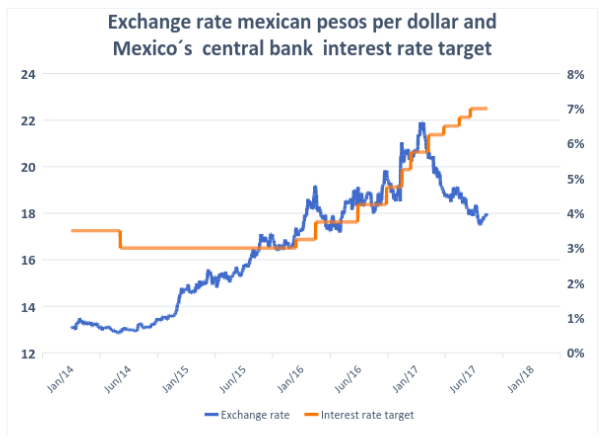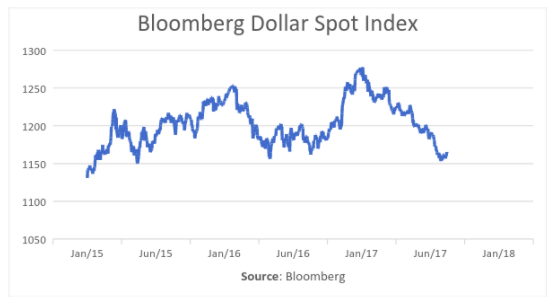Two Reasons Why The Mexican Peso Appreciated in 2017

At UFM Market Trends we have dedicated short articles and segments of our quarterly reports to analyze the erratic trend of the price of the Mexican peso since 2014.
How did it all start?
The devaluationary spiral of the peso began with the fall in oil prices in mid-2014. At the time, the depreciation was easy to explain in terms of the deterioration of the balance of trade. With Mexico being a net oil-exporting country, the fall of oil prices meant a fall in the country’s foreign currency revenue. This situation explains the depreciation of the peso of mid-2014 and all of 2015.
In 2016 the situation gets complicated
The victory of the Brexit referendum in June 2016 deteriorated expectations of the Mexican economy’s performance, lowering the price of the peso against the dollar.
Things got worse for the Mexican peso in November 2016, when Donald trump was elected as President of the United States. At the time, the pessimism that took hold of investors and speculation lead to a depreciated Mexican peso. As we explained in another article, the peso depreciated 14% in only three days after Trump’s victory.
Banxico reacted without success…
With this scenario, the Bank of Mexico (Banxico) begun a series of efforts to try to defend the peso by raising the benchmark interest rate in 2016. The following graph shows the price of the peso against the dollar on the left axis; on the right it shows the reference interest rate of Banxico. Banxico practically doubled its reference rate between July 2016 and July 2017.
Graph 1:

Source: Banxico
Two factors helping the peso in 2017
In 2017, things seem to be different for the Mexican peso. Between January and July of 2017, the peso appreciated on average 17% against the dollar. What are the reasons for this behavior? There are at least two.
1.The pessimism caused by Trumps victory has considerably decreased
If in November 2016, investors were nervous after Trumps victory: they anticipated an attack on NAFTA that would harm the Mexican market. On Wednesday, August 16 Canada, the US, and Mexico started renegotiating NAFTA.
Although there is much expectation for the results, most recognize that Mexico could gain from a NAFTA renegotiation. When the agreement was signed more than 20 years ago, the energy sector was controlled by the government. Since the energy reform by Peña Nieto, there have been proposals to integrate the energy market between the three countries.
This has reassured investors, and it is reflected in the peso’s price. Perhaps the speculative alarms launched the peso away from its “fundamental value” and today the markets reflect it with the peso’s appreciation
2.A weaker dollar
In 2017, the US dollar has weakened against other currencies. There was talk that the dollar traded at its lowest level against the euro in two years. However, the Bloomberg dollar spot index is a better indicator, since it compares the dollar against a basket of the world’s top ten most important currencies. Each currency in the basket and its weight are determined annually based on its share in international trade and its liquidity.
Graph 2:

In the graph we see how the dollar strengthened at the end of 2016, just after Trump’s victory and in subsequent months. When Trump announced major tax cuts, the optimist environment was reflected in a strong dollar. But the Republican’s failed attempt to dismantle the Affordable Care Act make a tax cut less likely.
What about Banxico’s efforts?
We could debate whether or not the Mexican central bank has been a decisive factor in the recovery of the exchange rate. In general, as seen in graph 1, we see that Banxico’s efforts were considerable in terms of the increase in reference rates. However, even though interest rates increased, the peso continued its trend to depreciate.
It is also not a Banxico mandate to have a determined exchange rate. Banxico had in mind its inflation target, which for now should be its concern as we mentioned in our last quarterly report. At least we can say that Banxico protected itself and resisted an attack that seems to have ended for the moment.
Get our free exclusive report on our unique methodology to predict recessions

Edgar Ortiz
Edgar Ortiz has a degree in Law from the Francisco Marroquín University. He holds a master in Austrian Economics at the Rey Juan Carlos University in Madrid. He is the executive director of the Center of Economic and Social Studies (CEES). He is a professor of economics at the Francisco Marroquín University, and he is also an analyst on issues related to the situation at Canal Antigua. He works as an associate lawyer at Estudio Jurídico Rivera.
Get our free exclusive report on our unique methodology to predict recessions


